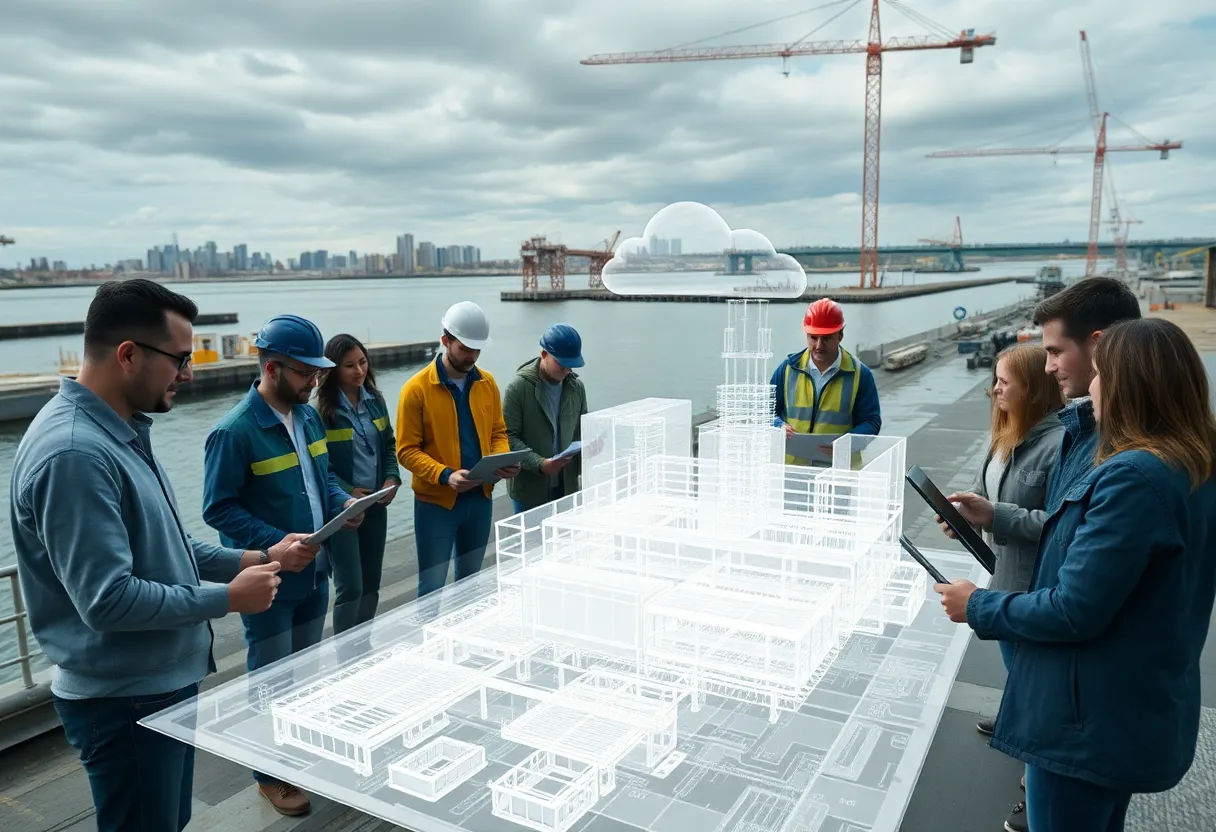Buffalo, New York, October 7, 2025
News Summary
The global Building Information Modeling (BIM) market is poised for rapid expansion, driven by advances in cloud computing, AI, VR/AR and IoT. Research forecasts significant market growth and strong CAGR as public and private sectors adopt BIM for complex projects, sustainability and smart-city initiatives. The USACE Buffalo District is applying BIM to infrastructure projects like Black Rock Lock miter gates and remediation at the Niagara Falls Store Site, reporting benefits in planning, clash detection and maintenance while facing challenges in file compatibility and data standards. Federal grants and labor dynamics further propel adoption across the industry.
Global BIM Market Set to Triple by 2030 as Government and Technology Push Adoption
Building Information Modeling (BIM) is gaining ground worldwide as a central tool for planning, designing, building and operating infrastructure. The global market for Building Information Modeling (BIM) was estimated at US$8.6 billion in 2023 (ResearchAndMarkets). ResearchAndMarkets projects the global BIM market will reach US$24.8 billion by 2030. ResearchAndMarkets projects a compound annual growth rate (CAGR) of 16.3% for BIM from 2023 to 2030.
Why the market is growing
Several practical and policy forces are pushing the trend. Increasing complexity of modern building projects has raised demand for a single platform that integrates structural, mechanical and electrical disciplines into a unified place for collaboration. Government mandates and regulatory requirements in many countries are requiring the use of BIM for large-scale infrastructure and public sector projects. Demand for sustainable construction practices is driving BIM adoption because BIM enables better energy modeling and lifecycle analysis. Growing investment in smart cities is propelling BIM adoption by enabling cohesive, data-driven planning, design and maintenance of infrastructure.
Technology and labor drivers
Cloud computing, artificial intelligence (AI), virtual and augmented reality (VR/AR) and the Internet of Things (IoT) are combining to make BIM more powerful and more useful on active projects. Cloud computing allows BIM data to be shared and accessed in real time by distributed stakeholders. AI integration with BIM can provide predictive analytics to foresee project risks, optimize schedules, anticipate material shortages, and identify potential design flaws. VR/AR allow stakeholders to immerse themselves in a 3D model and identify design issues prior to construction. IoT enables real-time data collection from sensors embedded in buildings that can be integrated into BIM models for ongoing performance analysis.
Labor trends also favor digital tools. Global construction industry labor shortages and a declining workforce are factors driving BIM adoption. BIM helps automate aspects of design and construction management to do more with fewer resources. The rising trend of prefabrication and modular construction relies heavily on BIM for precise coordination and planning.
What BIM does on projects
BIM provides a comprehensive digital representation of a building’s physical and functional characteristics across its lifecycle. BIM replaces fragmented 2D drawings with a cohesive 3D model containing rich data on every component, from structural elements to systems like HVAC and electrical. It enables early identification of potential design clashes or system conflicts, minimizing costly rework and delays during construction. BIM supports enhanced visualization such as simulations of building performance before construction starts and plays a role in operations and maintenance by providing a detailed, living record of a structure’s attributes for owners and managers.
Federal, state and project-level activity
Federal funding exists to encourage state departments of transportation to use technology like BIM. Last November, the Federal Highway Administration disbursed grants worth $16.6 million to eight states under the Advanced Digital Construction Management Systems program. In the public sector, a federal construction district has started using BIM in key projects and sees the work as a long-term investment in capability and data-driven asset management.
Case example: USACE Buffalo District
The Buffalo District (U.S. Army Corps of Engineers — USACE Buffalo District) has started using BIM. The Buffalo District is using BIM to model projects such as miter gates for the Black Rock Lock in downtown Buffalo. The Buffalo District is using BIM for remediation work at the Niagara Falls Store Site. Challenges the Buffalo District faces with BIM include ensuring file compatibility and enforcing data standards. The Buffalo District views BIM as an investment in future technology (as stated in a news release). Kevin Lesika, a geodesist with the Buffalo District’s survey team, is quoted in the release. Dustin Tellinghuisen, civil engineer at USACE Buffalo District, told the agency via email that USACE’s adoption of BIM was a direct result of the government’s push for modernization, digital transformation and improved data management in infrastructure delivery.
Private sector and other examples
Contractors in the private sector have long used BIM. Examples include projects where design-assist and digital modeling were used to integrate systems across multiple historic buildings. Prefabrication, modular work and complex renovations commonly rely on BIM models to coordinate trades and reduce on-site surprises. Operations teams also benefit from having a living asset model for maintenance and monitoring.
Industry context and workforce pressures
Industry analysis shows strong fundamentals and persistent workforce challenges. Construction spending crossed US$2 trillion and maintained a balanced trajectory in the first half of 2024. The construction sector’s employment level reached 8.3 million in July 2024, surpassing its previous peak of 7.7 million from 2006. Between August 2023 and July 2024, the construction industry had an average of 382,000 job openings each month. Talent shortages affect both skilled and unskilled positions and are expected to intensify with projected growth in construction activity. Demand is rising for digital skills such as data and analytics, cloud computing and software development.
What to watch next
- Policy and funding: federal programs and state grants can accelerate BIM uptake for public projects.
- Technology integration: AI, cloud and IoT are key enablers that will expand BIM capabilities.
- Workforce: shortages and shifting skills requirements will push firms toward digital tools to sustain productivity.
- Prefabrication and modular: growth in offsite construction will keep BIM central to coordination and quality control.
FAQ
What was the global BIM market value in 2023?
The global market for Building Information Modeling (BIM) was estimated at US$8.6 billion in 2023 (ResearchAndMarkets).
What does ResearchAndMarkets project for BIM by 2030?
ResearchAndMarkets projects the global BIM market will reach US$24.8 billion by 2030.
What growth rate is projected for BIM from 2023 to 2030?
ResearchAndMarkets projects a compound annual growth rate (CAGR) of 16.3% for BIM from 2023 to 2030.
Has the USACE Buffalo District adopted BIM?
The Buffalo District (U.S. Army Corps of Engineers — USACE Buffalo District) has started using BIM.
What projects is the Buffalo District modeling with BIM?
The Buffalo District is using BIM to model projects such as miter gates for the Black Rock Lock in downtown Buffalo.
Is the Buffalo District using BIM for remediation work?
The Buffalo District is using BIM for remediation work at the Niagara Falls Store Site.
What are some challenges the Buffalo District faces with BIM?
Challenges the Buffalo District faces with BIM include ensuring file compatibility and enforcing data standards.
Does federal funding support BIM-like technologies for states?
Federal funding exists to encourage state departments of transportation to use technology like BIM.
Were any recent federal grants disbursed for digital construction management?
Last November, the Federal Highway Administration disbursed grants worth $16.6 million to eight states under the Advanced Digital Construction Management Systems program.
{
“@context”: “https://schema.org”,
“@type”: “FAQPage”,
“mainEntity”: [
{
“@type”: “Question”,
“name”: “What was the global BIM market value in 2023?”,
“acceptedAnswer”: {
“@type”: “Answer”,
“text”: “The global market for Building Information Modeling (BIM) was estimated at US$8.6 billion in 2023 (ResearchAndMarkets).”
}
},
{
“@type”: “Question”,
“name”: “What does ResearchAndMarkets project for BIM by 2030?”,
“acceptedAnswer”: {
“@type”: “Answer”,
“text”: “ResearchAndMarkets projects the global BIM market will reach US$24.8 billion by 2030.”
}
},
{
“@type”: “Question”,
“name”: “What growth rate is projected for BIM from 2023 to 2030?”,
“acceptedAnswer”: {
“@type”: “Answer”,
“text”: “ResearchAndMarkets projects a compound annual growth rate (CAGR) of 16.3% for BIM from 2023 to 2030.”
}
},
{
“@type”: “Question”,
“name”: “Has the USACE Buffalo District adopted BIM?”,
“acceptedAnswer”: {
“@type”: “Answer”,
“text”: “The Buffalo District (U.S. Army Corps of Engineers — USACE Buffalo District) has started using BIM.”
}
},
{
“@type”: “Question”,
“name”: “What projects is the Buffalo District modeling with BIM?”,
“acceptedAnswer”: {
“@type”: “Answer”,
“text”: “The Buffalo District is using BIM to model projects such as miter gates for the Black Rock Lock in downtown Buffalo.”
}
},
{
“@type”: “Question”,
“name”: “Is the Buffalo District using BIM for remediation work?”,
“acceptedAnswer”: {
“@type”: “Answer”,
“text”: “The Buffalo District is using BIM for remediation work at the Niagara Falls Store Site.”
}
},
{
“@type”: “Question”,
“name”: “What are some challenges the Buffalo District faces with BIM?”,
“acceptedAnswer”: {
“@type”: “Answer”,
“text”: “Challenges the Buffalo District faces with BIM include ensuring file compatibility and enforcing data standards.”
}
},
{
“@type”: “Question”,
“name”: “Does federal funding support BIM-like technologies for states?”,
“acceptedAnswer”: {
“@type”: “Answer”,
“text”: “Federal funding exists to encourage state departments of transportation to use technology like BIM.”
}
},
{
“@type”: “Question”,
“name”: “Were any recent federal grants disbursed for digital construction management?”,
“acceptedAnswer”: {
“@type”: “Answer”,
“text”: “Last November, the Federal Highway Administration disbursed grants worth $16.6 million to eight states under the Advanced Digital Construction Management Systems program.”
}
}
]
}
Key features at a glance
| Feature | Detail |
|---|---|
| 2023 market size | US$8.6 billion |
| 2030 projection | US$24.8 billion |
| Projected CAGR | 16.3% (2023 to 2030) |
| Main drivers | Project complexity, government mandates, sustainability, smart-city investment, labor shortages |
| Key technologies | Cloud computing, AI, VR/AR, IoT |
| Public-sector example | The Buffalo District is using BIM to model projects such as miter gates for the Black Rock Lock in downtown Buffalo |
| Funding example | Last November, the Federal Highway Administration disbursed grants worth $16.6 million to eight states under the Advanced Digital Construction Management Systems program |
Deeper Dive: News & Info About This Topic
Additional Resources
- Construction Dive: USACE Buffalo District adopts BIM
- Wikipedia: Building information modeling
- Deloitte: Engineering and Construction industry outlook
- Google Search: Construction industry trends 2024
- G2 Learn: Construction statistics
- Google Scholar: Construction statistics 2024
- GlobeNewswire: Building Information Modeling (BIM) Industry research 2024
- Encyclopedia Britannica: Building information modeling
- BusinessWire: Artificial Intelligence (AI) in Construction report
- Google News: AI in construction
Author: Construction NY News
The NEW YORK STAFF WRITER represents the experienced team at constructionnynews.com, your go-to source for actionable local news and information in New York and beyond. Specializing in "news you can use," we cover essential topics like product reviews for personal and business needs, local business directories, politics, real estate trends, neighborhood insights, and state news affecting the area—with deep expertise drawn from years of dedicated reporting and strong community input, including local press releases and business updates. We deliver top reporting on high-value events such as the New York Build Expo, infrastructure breakthroughs, and cutting-edge construction technology showcases. Our coverage extends to key organizations like the Associated General Contractors of New York State and the Building Trades Employers' Association, plus leading businesses in construction and real estate that power the local economy such as Turner Construction Company and CMiC Global. As part of the broader network, including constructioncanews.com, constructiontxnews.com, and constructionflnews.com, we provide comprehensive, credible insights into the dynamic construction landscape across multiple states.





